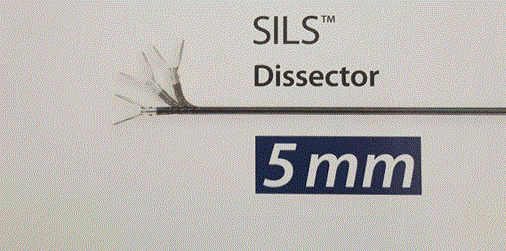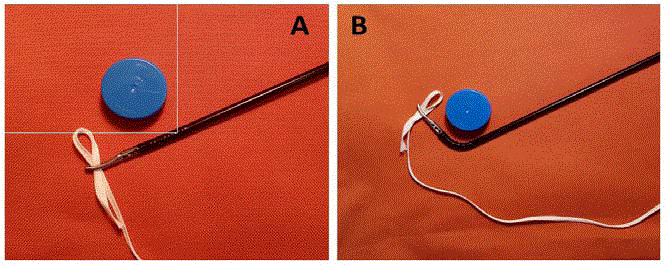Case Report
Flexible Way to Encirclethe Inferior Vena Cava in Minimally-Invasive Surgery
Gil-Jaurena Juan-Miguel1,2*, Pita Ana1,2 and De la Torre Manuel3
1Department of Pediatric Cardiac Surgery, Hospital Gregorio Marañón, Spain
2Gregorio Marañón Health Research Institute, Spain
3Department of Pediatric Surgery, Hospital Gregorio Marañón, Spain
*Corresponding author: Gil-Jaurena Juan-Miguel, Department of Pediatric Cardiac Surgery, Hospital Gregorio Marañón, C/O Donnell nº 50, 28009, Madrid, Spain
Published: 18 May, 2018
Cite this article as: Juan-Miguel G-J, Ana P, De la Torre
Manuel. Flexible Way to Encirclethe
Inferior Vena Cava in Minimally-
Invasive Surgery. Clin Surg. 2018; 3:
1968.
Abstract
A new and simple trick to encircle the Inferior Vena Cava (IVC) in minimally invasive cardiac surgery is depicted. With the aid of a shafted, flexible-tip dissector, the IVC is surrounded with a tape for its exclusion in a gentle movement.
Case Presentation
Minimally invasive cardiac surgery has reached its adulthood [1-4]. Many groups report their outstanding results and pave the way with tips and pit falls for the sake of anyone´s learning curve [5]. Our own group has been performing minimally invasive congenital cardiac surgery for more than fifteen years, incorporating new approaches and addressing new cardiac conditions as experience and technology evolves [6]. Several tools, either borrowed from other surgical disciplines (soft tissue retractor, shafted instruments) or specifically designed for cardiac surgery (transthoracic and flexible aortic clamps) have been added step by step to deal with hurdles in the way. One of the latest issues to be addressed is how to encircle the Inferior Vena Cava (IVC) from a distant and narrow approach. Regular dissectors are cumbersome to drive because little room is left to rock them through a tiny entrance. Deployment of bull dogs (with a shafted forceps) is an alternative when peripheral cannulation is employed. Looking for a long, bendable-tip instrument (Figure 1) we bump into SILSTM Dissect (Covidien, 555 Long Wharf Drive, New Haven, CT, USA). It is commonly used in Single Incision Laparoscopic Surgery (SILS) by our colleagues in Pediatric Surgery, and proved useful to tackle our purpose. Once on by-pass and with an empty decompressed heart, blunt dissection between the IVC and right inferior pulmonary vein is carried out. Having developed the obliques in us, the instrument, with a folded tape grabbed in its tip (Figure 2A), is slipped under the IVC. Then, after reaching 90 degrees deflection, the folded tape on the tip appears above the IVC pointing towards the operator (Figure 2B). Finally, the tape is grasped with shafted forceps and the flexible dissector is released. The authors find this easy maneuver particularly appealing for video-assisted mini-thoracotomy approaches (3 cm to 4 cm incision) and axillary entrance through the third inter costal space in small children (5 cm to 6 cm incision) which is our usual approach for sinus venosus atrial septal defect with partial anomalous pulmonary venous drainage in the superior vena cava. In both cases, the IVC is somehow distant from the tiny surgical incision. Grasping the tape in a folded way provides it with a stiffer and “C-like” shape after deflection, making it easier to be caught by the surgeon (Clinical Video).
Figure 1
Figure 2
Figure 2
A. Dissector slipped under the inferior vena cava (blue circle), grasping a folded tape. B. Bended
dissector, providing a stiff and “C-like” shape device to be grabbed.
Conclusion
Transition to minimally invasive surgery deserves commitment and confidence towards proficiency. Commitment to keep the same or even better results than standard approaches [7,8]. Confidence that any “unsurmountable” hurdle can be overcome8withboldtricks and new tools; sometimes, found next door.
References
- Mohr FW, Falk V, Diegeler A, Walther T, van Son JA, Autschbach R. Minimally invasive port-access mitral valve surgery. J Thorac Cardiovasc Surg. 1998;115(3):567-74.
- Casselman FP, Van Slycke S, Dom H, Lambrechts DL, Vermeulen Y, Vanermen H. Endoscopic mitral valve repair: feasible, reproducible, and durable. J Thorac Cardiovasc Surg. 2003;125(2):273-82.
- Modi P, Hassan A, Chitwood WR Jr. Minimally invasive mitral valve surgery: a systematic review and meta-analysis. Eur J Cardiothorac Surg. 2008;34(5):943-52.
- Argenziano M, Oz MC, Kohmoto T, Morgan J, Dimitui J, Mongero L, et al. Totally endoscopic atrial septal defect repair with robotic assistance. Circulation. 2003;108(1):II191-4.
- Bonaros N, Schachner T, Oehlinger A, Ruetzler E, Kolbitsch C, Dichtl W, et al. Robotically assisted totally endoscopic atrial septal defect repair: insights from operative times, learning curves, and clinical outcome. Ann Thorac Surg. 2006;82(2):687-93.
- Gil-Jaurena JM, González-López MT, Pérez-Caballero R, Pita A, Castillo R, Miró L. [15 years of minimally invasive paediatric cardiac surgery; development and trends]. An Pediatr (Barc). 2016;84(6):304-10.
- Chu MW, Losenno KL, Fox SA, Adams C, Al-Habib H, Guo R, et al. Clinical outcomes of minimally invasive endoscopic and conventional sternotomy approaches for atrial septal defect repair. Can J Surg. 2014;57(3):E75-81.
- Gil-Jaurena JM, Pérez-Caballero R, Pita-Fernández A, González-López MT, Sánchez J, De Agustín JC. How to set-up a program of minimally invasive surgery for congenital heart defects. Transl Pediatr. 2016;5(3):125-33.


